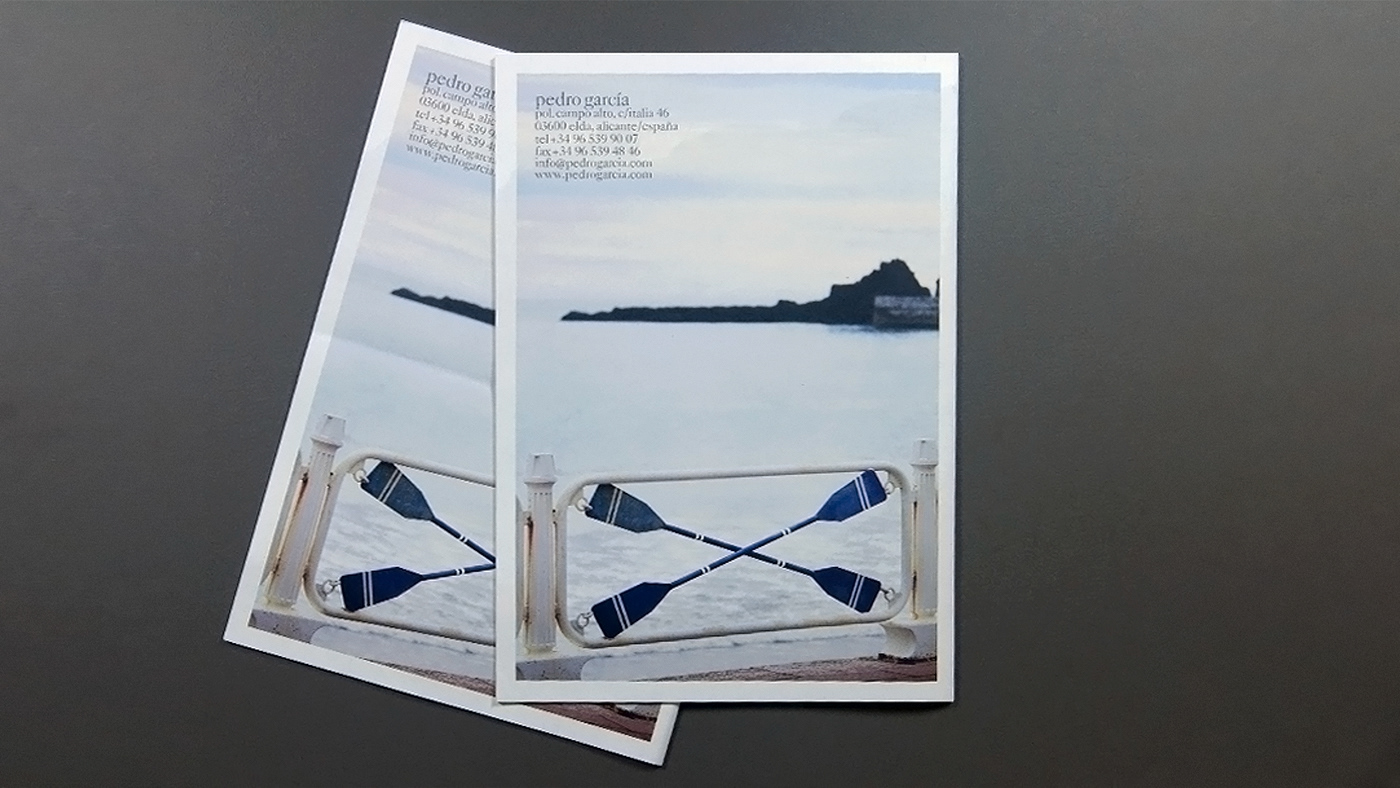pedro garcía
Made in Spain
Asturias
Contents and Texts
The place in Spain selected for Pedro García’s Spring Summer 2014 was the Cantabrian coast of Asturias, at the northwest of the country. The brand creative directors chose to focus the main contents of the newspaper-catalog on the local traditions and craftwork. They also wanted the campaign to be based on the idea of escaping from routine and its claim had to be understood in English and Spanish. We proposed Hasta la vista! The rest of the copywriting had to reflect the relaxed intimate atmosphere of the natural environment and communicate the savoir vivre of the people from the area. These features and copywriting were also used as social media contents and in newsletters. The art direction and graphic design is by Daniel Ayuso for clase bcn.
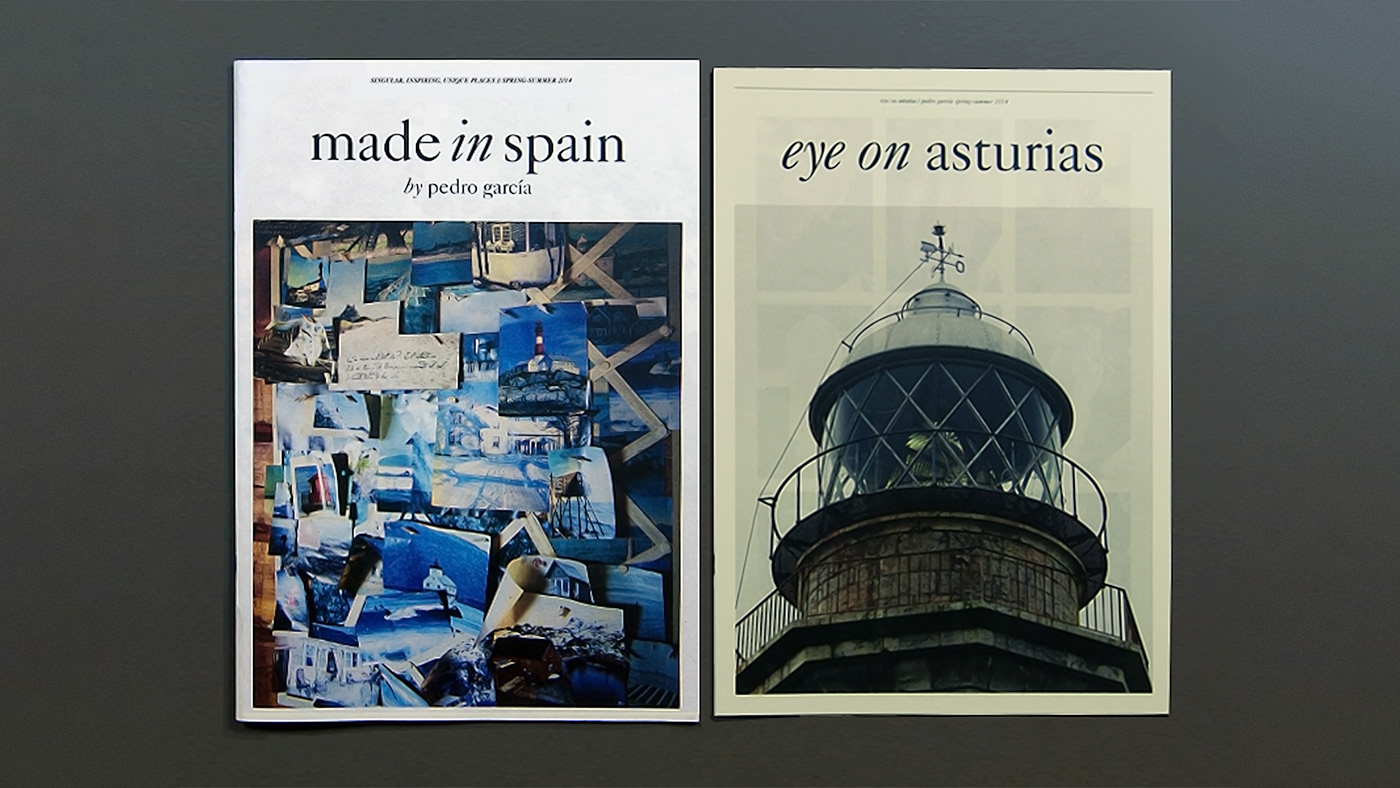

Hasta la vista!
Adios to traffic jams, email, clocks and the background bleeping and buzz of the city. Hasta luego, daily grind. So this story begins. With a farewell and a quick getaway. Exhilarating, long-anticipated and well-deserved. But the explosive rush for freedom soon gives way to the slow dawning of a revelation. First there are hints. Little things you notice. Subtle indications that you’re somewhere very special. The finely-graduated shades of green, the endless blue, the sun that doesn’t want to set, the cows grazing next to the beach, the ever-present hydrangeas, long grass swishing, lush meadows that touch the sand, salt breezes, apple-scented air, creaking timber, cliff-top lighthouses, the old-fashioned coverlet on the bed. Then you meet the people. The element that brings this universe to life. And finally you realize that this is a place with its own wisdom, its own savoir vivre. The land of the Cantabrian sea. Charismatic and seductive. A place where time is an indulgence, where it flows slowly, languidly. Where life’s treasures aren’t bought, they are inherited, because they are the traditions and experience of master craftsmen. A unique, beguiling place: Pedro García’s Asturias.
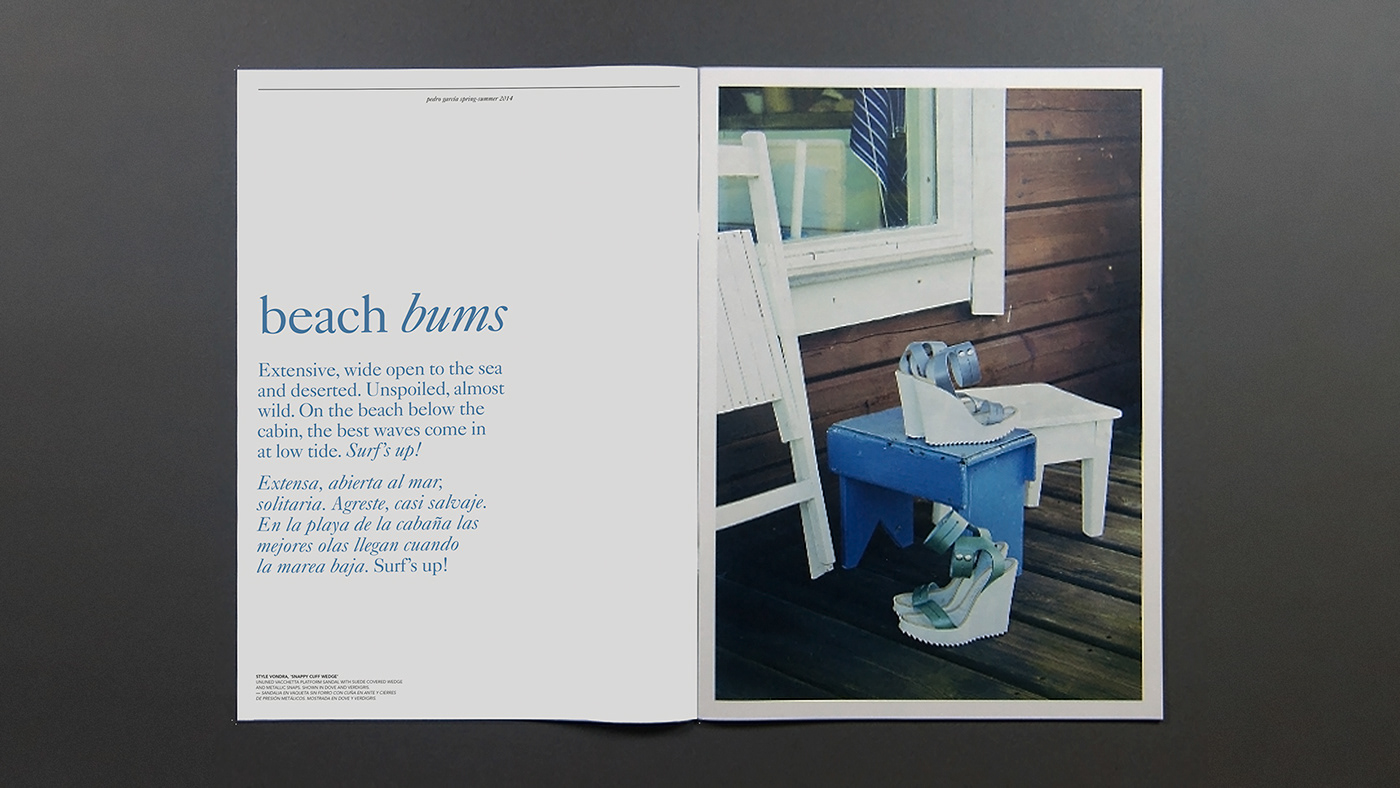
Beach Bums
Extensive, wide open to the sea and deserted. Unspoiled, almost wild. On the beach below the cabin, the best breakers come in at low tide. Surf’s up!
Style Vondra, 'snappy cuff wedge' –
Unlined vacchetta platform sandal with suede covered wedge and metallic snaps. Shown in dove and verdigris.

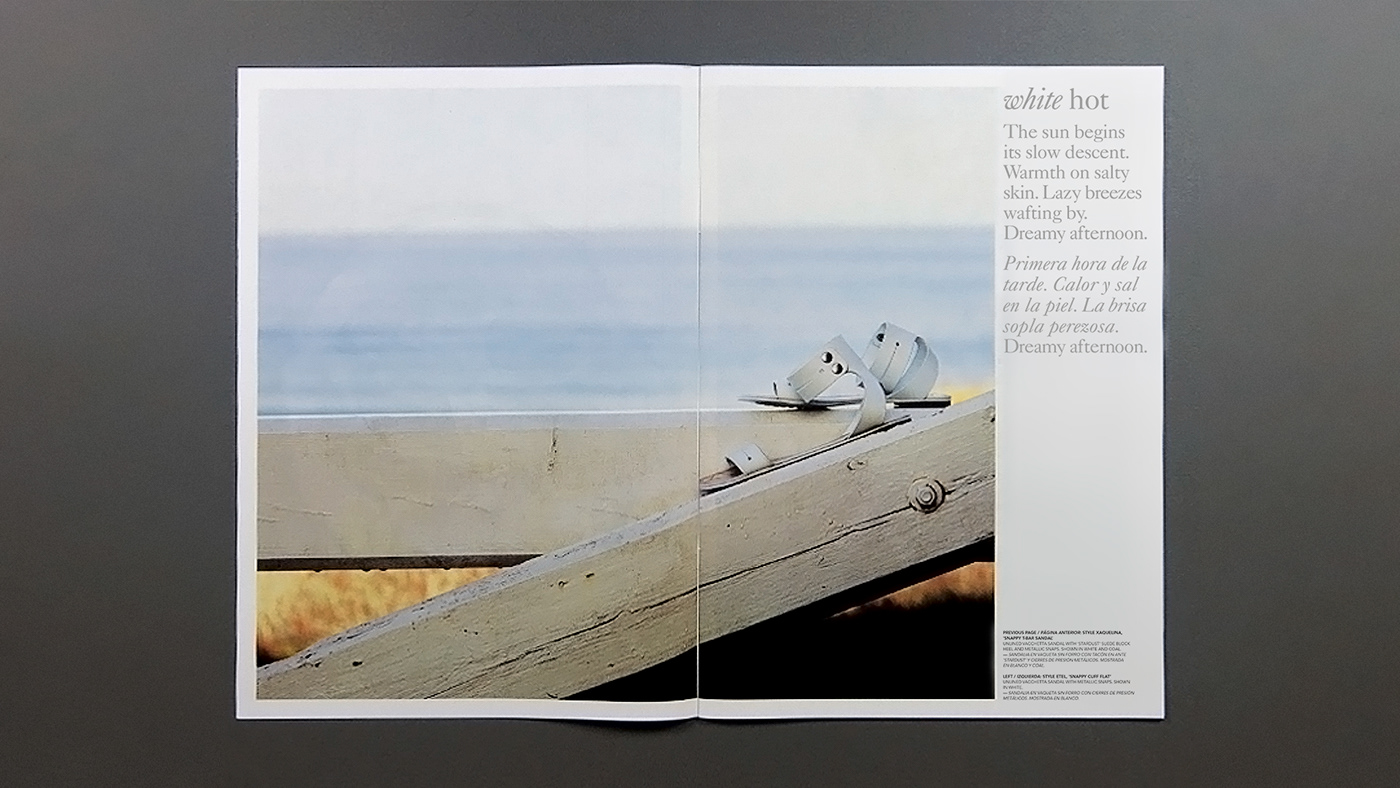
White hot
The sun begins its slow descent. Warmth on salty skin.
Lazy breezes wafting by. Dreamy afternoon.
Previous page: Style Xaquelina,‘snappy t-bar sandal’ –
Unlined vacchetta sandal with ‘stardust’ suede block heel and metallic snaps. Shown in white and coal.
Left : Style Etel, ‘snappy cuff flat’ –
Unlined vacchetta sandal with metallic snaps. Shown in white.


Previous page: Style Xola, 'snappy cuff sandal' –
Unlined vacchetta sandal with 'stardust' suede block heel and metallic snaps. Shown in almond and chalk.
Opposite page: Style Evans, 'snappy t-bar flat' –
Unlined vacchetta sandal with metallic snaps. Shown in verdigris and dove.

Catch of the day
Left: Style Samanta, 'snappy cuff open-toe' –
Unlined raw edge suede cowhide open-toe with vacchetta cuff and metallic snaps. Shown in adobe and black.
Right: Style Sheryl, 'snappy t-cuff sandal' –
Unlined raw edge suede cowhide and vacchetta ankle-strap sandal with silver snaps. Shown in adobe and black.
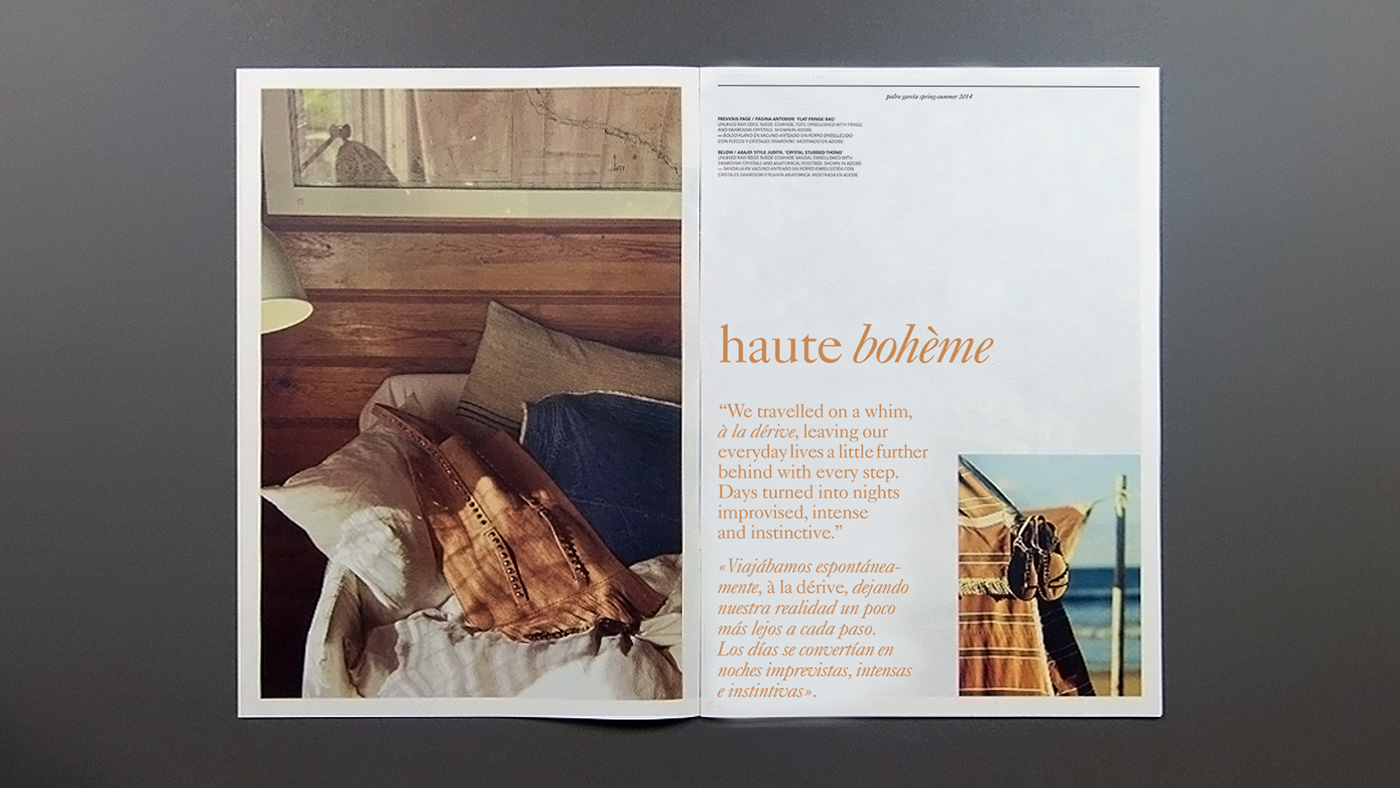
Haute Bohème
“We travelled on a whim, à la dérive, leaving our everyday lives a little further behind with every step.
Days turned into nights, improvised, intense and instinctive.”
Previous page: 'Flat fringe bag' –
Unlined raw edge suede cowhide tote embellished with fringe and Swarovski crystals. Shown in adobe.
Below: Style Judith, 'crystal studded thong' –
Unlined raw edge suede cowhide sandal with anatomical footbed embellished with Swarovski crystals. Shown in adobe.

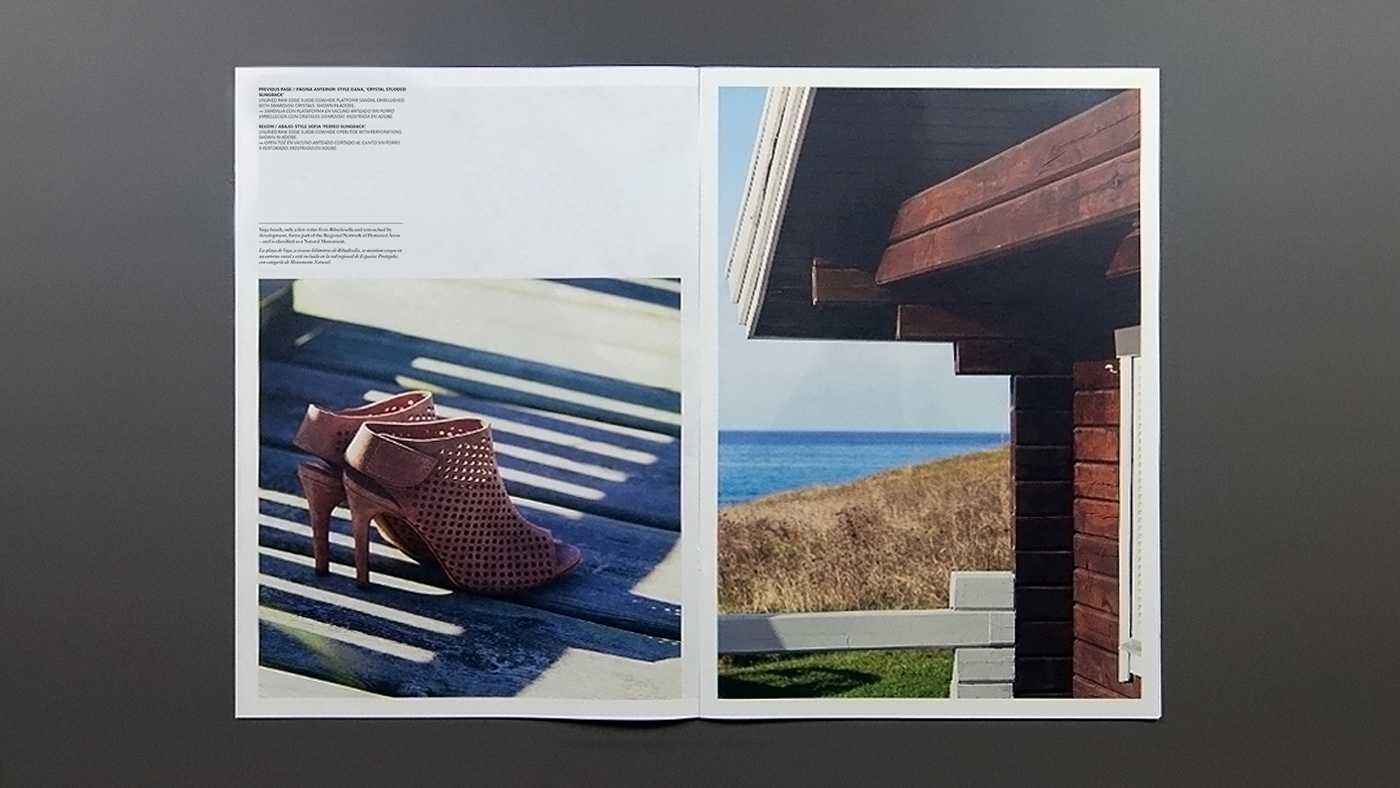
Previous page: Style Dana, 'crystal studded sling-back' –
Unlined raw edge suede cowhide platform sandal embellished with Swarovski crystals. Shown in adobe.
Below: Style Sofia ‘perfed slingback’ –
Unlined raw edge suede cowhide open-toe with perforations. Shown in adobe.
Vega beach, only a few miles from Ribadesella and untouched by development, forms part of the Regional Network of Protected Areas – and is classified as a Natural Monument.


Muyeres
Sonia takes a seat, center stage. She holds a kind of rustic fiddle that has been played across Spain since medieval times, and is known in Asturias as the bandurria. Drawing the bow across the strings she beings to sing. Suddenly, in the school hall where the rehearsal takes place, there is nothing but her voice. Behind her, in their traditional costumes – all felt, cotton, wool, wood and leather – stand the other twenty-three members of the Colectivu Muyeres, the Asturian traditional music association, but it is as if they have melted into the air. Sonia’s ethereal voice transports the tiny audience from the hall, into a world that is green, rural and remote but – thanks to the Colectivu Muyeres – not forgotten.
This is the Asturias of times gone by, in which which women were the guardians of culture, singing while they worked in the home or the fields, while they taught children to play, rocked the baby or marked family celebrations, accompanied by makeshift percussion – two spoons or a frying pan. Simple, heartfelt and profoundly moving. “Muyeres was founded twenty years ago to raise awareness of traditional Asturian music, as passed from one generation to the next by women, and to reclaim their role as the guardians of culture,” explains Mavisa, another member of the group, when we return to the 20th century.
The project began when a group of Asturian women came together to record an album of traditional music, entitled Muyeres. The group was formalized as an association, and went on to record three more song collections, in the process saving more than 200 songs for posterity. Their first show, Ainda Suenen, ‘they can still be heard’ – a ninety-minute journey through emotions and human experience – happiness, love, work, spirituality and ceremony – was a huge success. At present they are preparing two new concerts: Muyeres en concierto, twenty years performing in Asturias, and Asturies 1952.
On the stage, Mari Luz sings. ‘Siempre sola, siempre sola.’ Alone, always alone. Perhaps it’s the simplicity and vulnerability of the lyric, and its contrast with the confident presence of the singer, but for a second, I’m struck by the dedication of these lawyers, doctors, historians, music teachers, professional singers and housewives. Busy women with families, who find time to rehearse, to record albums and perform. To bring their culture to a wider audience, and preserve its memory. In the final piece, in a playful gesture that mixes innocence and cheekiness, the performers briefly hoist their petticoats, showing the bow that holds up their stockings: as we applaud, it’s impossible not to smile.
Sonia takes a seat, center stage. She holds a kind of rustic fiddle that has been played across Spain since medieval times, and is known in Asturias as the bandurria. Drawing the bow across the strings she beings to sing. Suddenly, in the school hall where the rehearsal takes place, there is nothing but her voice. Behind her, in their traditional costumes – all felt, cotton, wool, wood and leather – stand the other twenty-three members of the Colectivu Muyeres, the Asturian traditional music association, but it is as if they have melted into the air. Sonia’s ethereal voice transports the tiny audience from the hall, into a world that is green, rural and remote but – thanks to the Colectivu Muyeres – not forgotten.
This is the Asturias of times gone by, in which which women were the guardians of culture, singing while they worked in the home or the fields, while they taught children to play, rocked the baby or marked family celebrations, accompanied by makeshift percussion – two spoons or a frying pan. Simple, heartfelt and profoundly moving. “Muyeres was founded twenty years ago to raise awareness of traditional Asturian music, as passed from one generation to the next by women, and to reclaim their role as the guardians of culture,” explains Mavisa, another member of the group, when we return to the 20th century.
The project began when a group of Asturian women came together to record an album of traditional music, entitled Muyeres. The group was formalized as an association, and went on to record three more song collections, in the process saving more than 200 songs for posterity. Their first show, Ainda Suenen, ‘they can still be heard’ – a ninety-minute journey through emotions and human experience – happiness, love, work, spirituality and ceremony – was a huge success. At present they are preparing two new concerts: Muyeres en concierto, twenty years performing in Asturias, and Asturies 1952.
On the stage, Mari Luz sings. ‘Siempre sola, siempre sola.’ Alone, always alone. Perhaps it’s the simplicity and vulnerability of the lyric, and its contrast with the confident presence of the singer, but for a second, I’m struck by the dedication of these lawyers, doctors, historians, music teachers, professional singers and housewives. Busy women with families, who find time to rehearse, to record albums and perform. To bring their culture to a wider audience, and preserve its memory. In the final piece, in a playful gesture that mixes innocence and cheekiness, the performers briefly hoist their petticoats, showing the bow that holds up their stockings: as we applaud, it’s impossible not to smile.
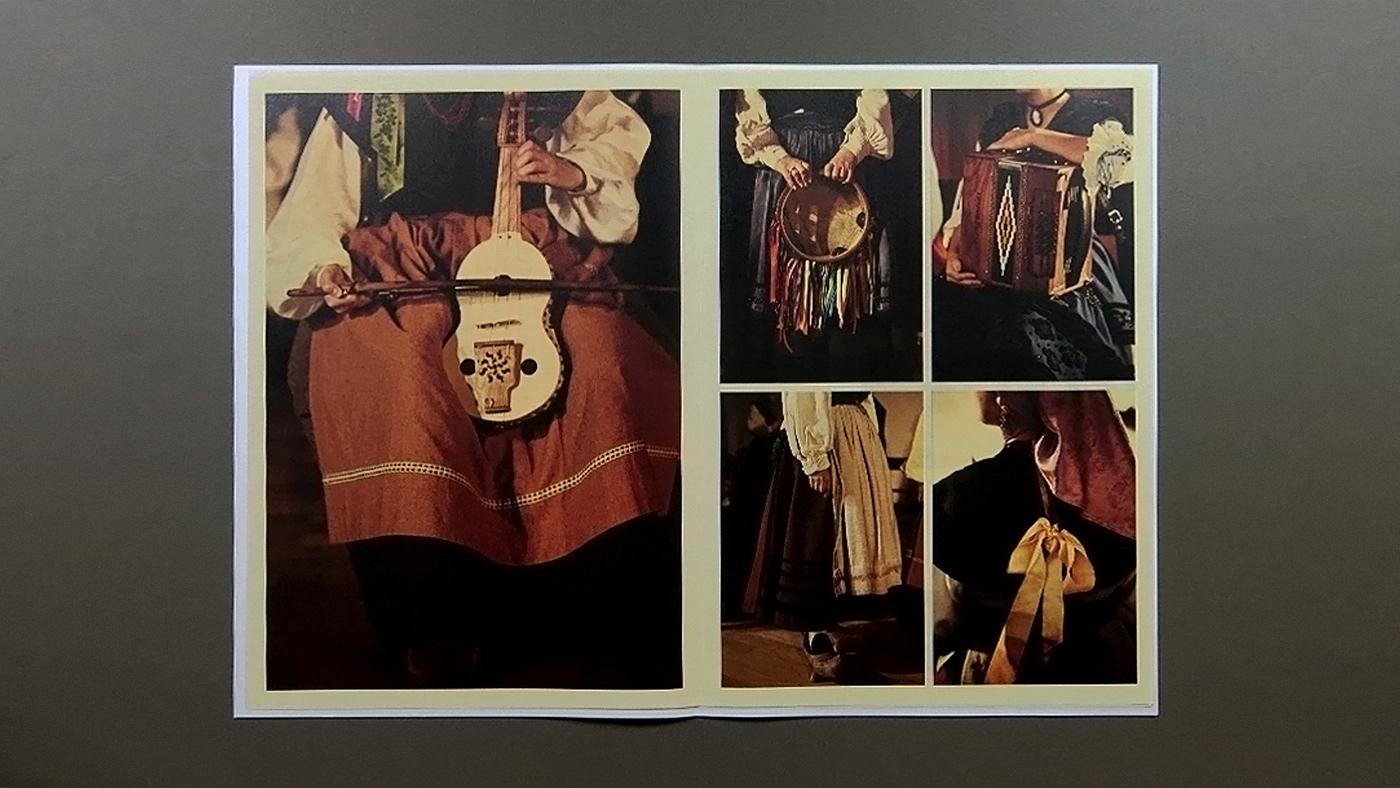
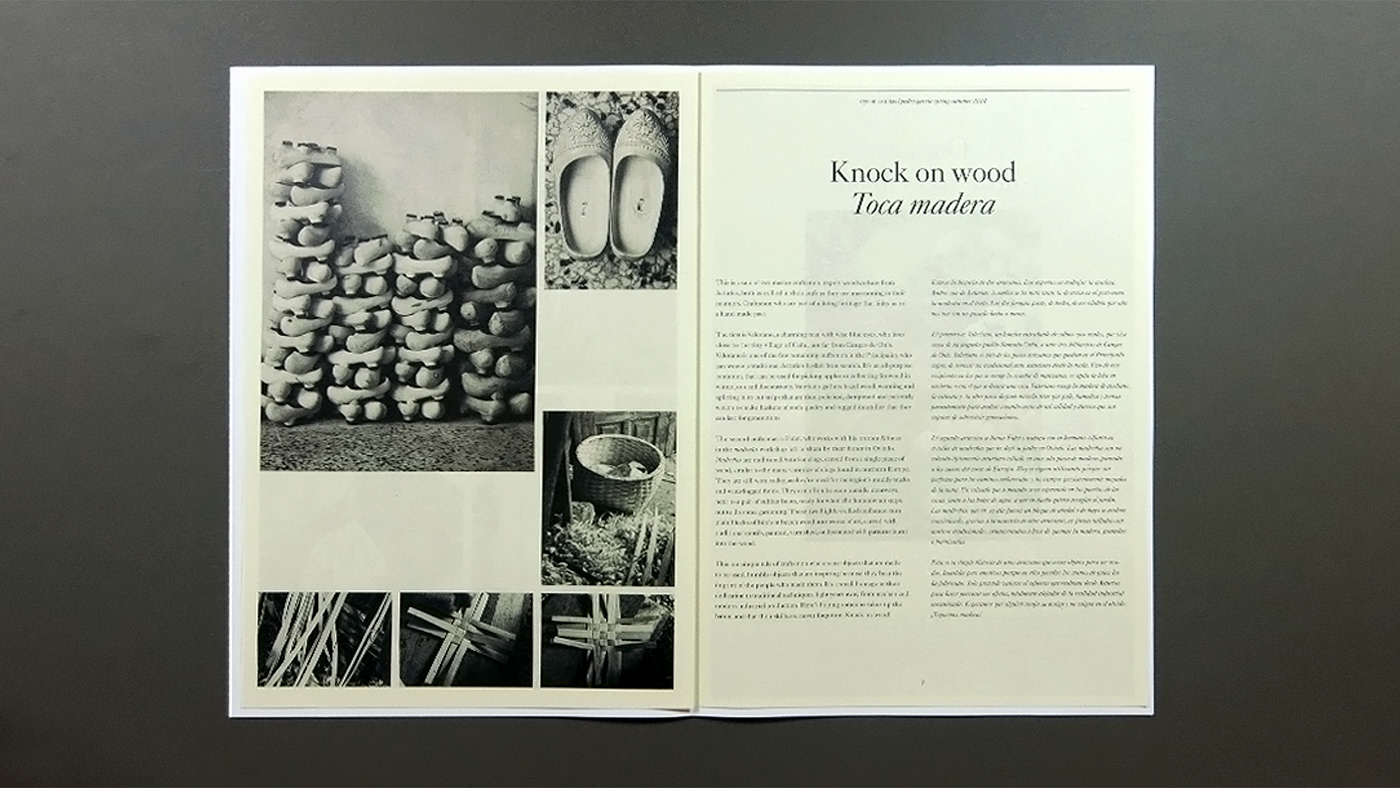
Knock on wood
This is a tale of two master craftsmen, expert woodworkers from Asturias, both as skilled in their craft as they are unassuming in their manners. Craftsmen who are part of a living heritage that links us to a hand-made past.
The first is Valeriano, a charming man with wise blue eyes, who lives close to the tiny village of Caño, not far from Cangas de Onís. Valeriano is one of the few remaining craftsmen in the Principality who can weave a traditional Asturian basket from scratch. It’s an all-purpose container, that can be used for picking apples or collecting firewood in winter, or used decoratively. Valeriano gathers hazel wood, warming and splitting it, to cut strips that are then polished, dampened and patiently woven to make baskets of such quality and rugged durability that they can last for generations.
The second craftsman is Fidel, who works with his brother Alfonso in the madreña workshop left to them by their father in Gijón. Madreñas are traditional Asturian clogs, carved from a single piece of wood, similar to the many varieties of clogs found in northern Europe. They are still worn today, as they’re ideal for the region’s muddy tracks and waterlogged fields. They can often be seen outside doorways, next to a pair of rubber books, ready for when the homeowner steps out to do some gardening. These two highly-skilled craftsmen turn plain blocks of birch or beech wood into works of art, carved with traditional motifs, painted, varnished, or decorated with patterns burnt into the wood.
This is a simple tale of craftsmen who create objects that are made to be used, humble objects that are inspiring because they bear the imprint of the people who made them. It’s a small homage to their dedication to traditional techniques, light years away from mechanized, modern industrial production. Here’s hoping someone takes up the baton, and that their skills are never forgotten. Knock on wood!
This is a tale of two master craftsmen, expert woodworkers from Asturias, both as skilled in their craft as they are unassuming in their manners. Craftsmen who are part of a living heritage that links us to a hand-made past.
The first is Valeriano, a charming man with wise blue eyes, who lives close to the tiny village of Caño, not far from Cangas de Onís. Valeriano is one of the few remaining craftsmen in the Principality who can weave a traditional Asturian basket from scratch. It’s an all-purpose container, that can be used for picking apples or collecting firewood in winter, or used decoratively. Valeriano gathers hazel wood, warming and splitting it, to cut strips that are then polished, dampened and patiently woven to make baskets of such quality and rugged durability that they can last for generations.
The second craftsman is Fidel, who works with his brother Alfonso in the madreña workshop left to them by their father in Gijón. Madreñas are traditional Asturian clogs, carved from a single piece of wood, similar to the many varieties of clogs found in northern Europe. They are still worn today, as they’re ideal for the region’s muddy tracks and waterlogged fields. They can often be seen outside doorways, next to a pair of rubber books, ready for when the homeowner steps out to do some gardening. These two highly-skilled craftsmen turn plain blocks of birch or beech wood into works of art, carved with traditional motifs, painted, varnished, or decorated with patterns burnt into the wood.
This is a simple tale of craftsmen who create objects that are made to be used, humble objects that are inspiring because they bear the imprint of the people who made them. It’s a small homage to their dedication to traditional techniques, light years away from mechanized, modern industrial production. Here’s hoping someone takes up the baton, and that their skills are never forgotten. Knock on wood!

Darn it!
Fishing nets are gigantic expanses of mesh, surprisingly silky and smooth to the touch. But even more than their size and their softness, it’s the colors that make them so striking. Rich burgundies mixed with mauves and pinks and combined with moss green, saffron and black. The entire palette in one net. None are a single piece: they’re made of sections in different colors. This is because they’re prone to rips or tears when the boats go out to fish at night, and the rederas – the “emergency fishnet doctors”, as they’re known – mend them during the daytime. Each shade is a piece that has been added, so that every net resembles a sort of tulle patchwork. With a technique similar to crochet, the rederas patiently join each patch to the whole. Knit one, purl two!
Fishing nets are gigantic expanses of mesh, surprisingly silky and smooth to the touch. But even more than their size and their softness, it’s the colors that make them so striking. Rich burgundies mixed with mauves and pinks and combined with moss green, saffron and black. The entire palette in one net. None are a single piece: they’re made of sections in different colors. This is because they’re prone to rips or tears when the boats go out to fish at night, and the rederas – the “emergency fishnet doctors”, as they’re known – mend them during the daytime. Each shade is a piece that has been added, so that every net resembles a sort of tulle patchwork. With a technique similar to crochet, the rederas patiently join each patch to the whole. Knit one, purl two!
Right: Style Judith, ‘crystal studded gladiator’ –
Unlined raw edge suede cowhide sandal with anatomical footbed embellished with Swarovski crystals. Shown in adobe.
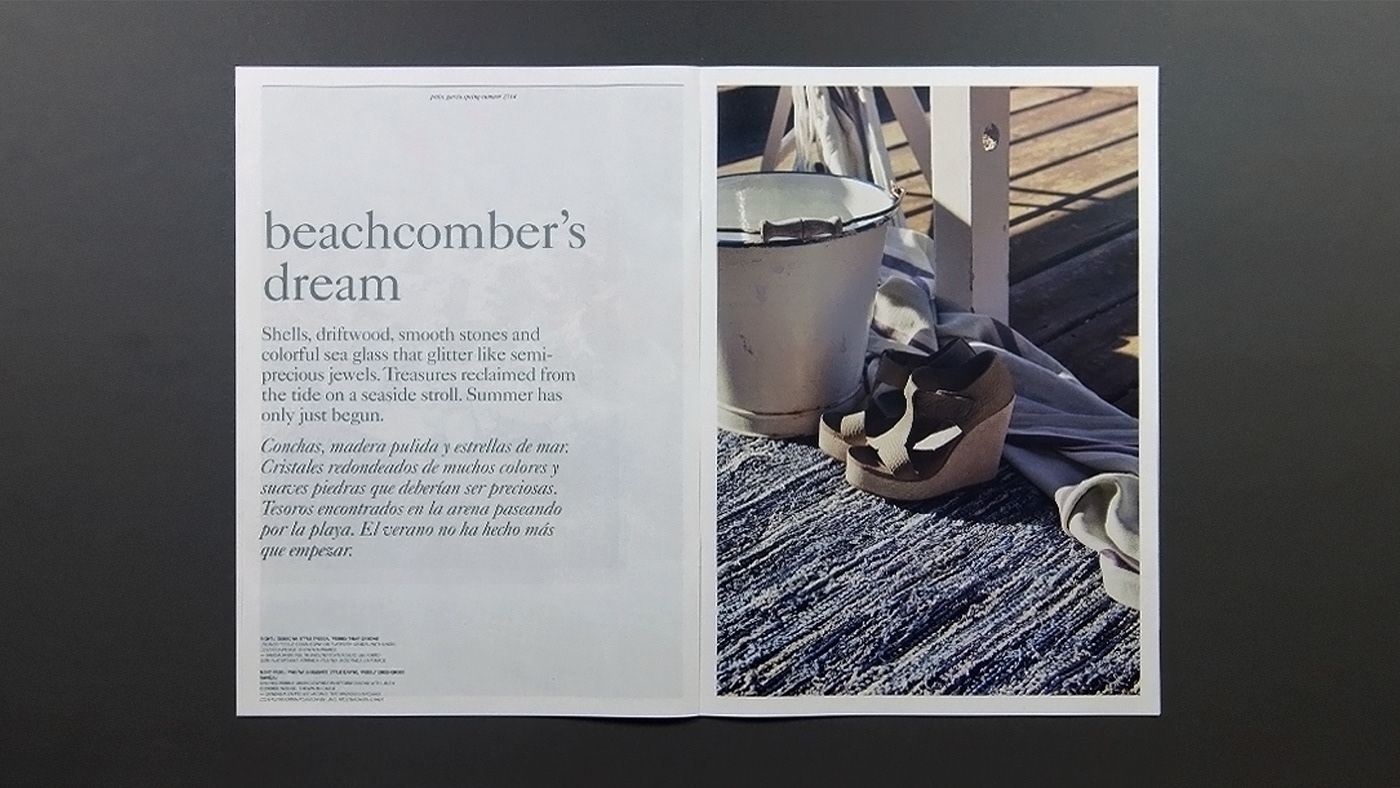
Beachcomber’s dream
Shells and starfish, polished sea glass of every color, and smooth stones that glitter like jewels.
Treasures reclaimed from the tide on a seaside stroll. Summer has only just begun.
Right: Style Tressa, pebbly t-bar sandal –
Unlined pebble grain cowhide platform sandal with linen covered wedge. Shown in pumice.
Next page: Style Dafne, pebbly criss-cross sandal –
Unlined pebble grain cowhide platform sandal with linen covered wedge. Shown in chalk.
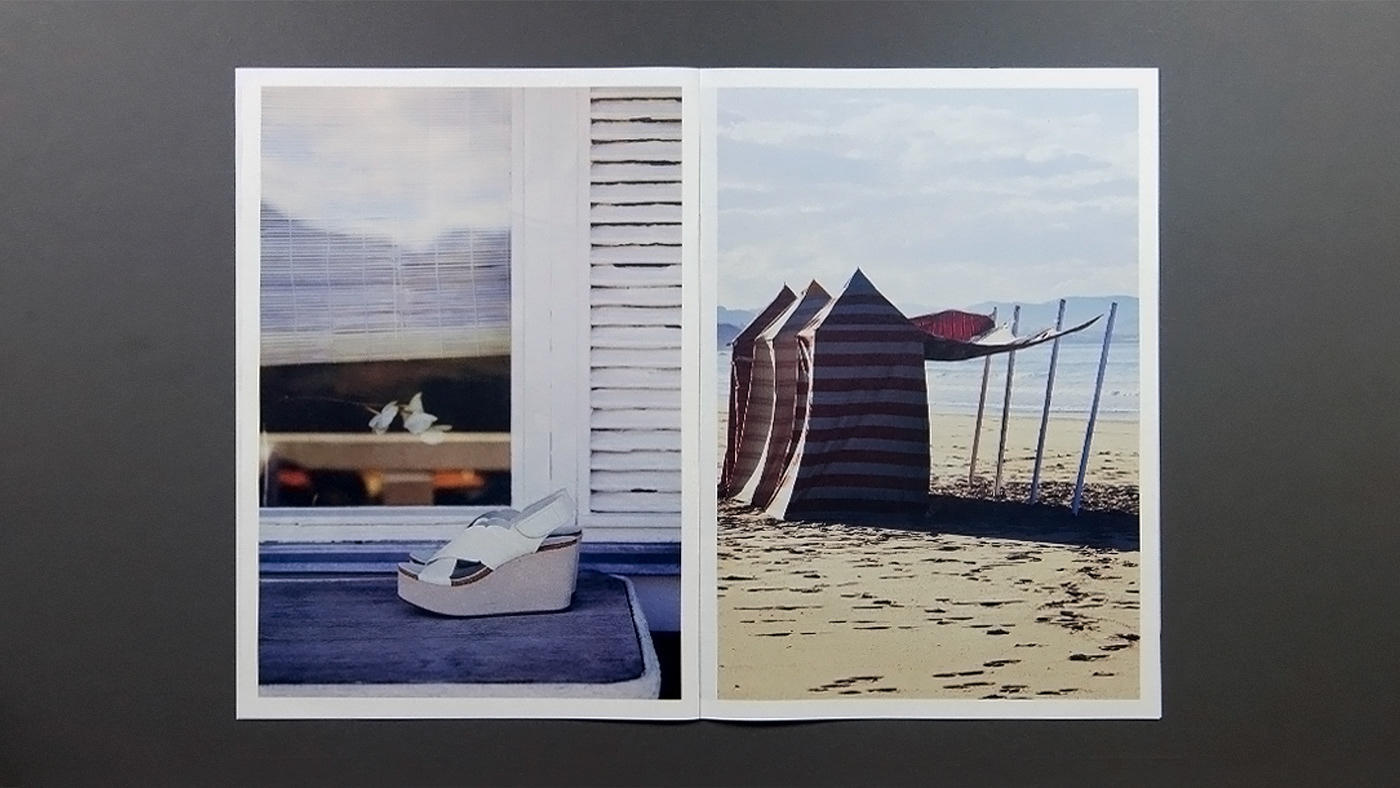


Sunset strip
It doesn’t happen every night, but sometimes the last rays of sunshine turn the horizon pink,
with hints of ocher and terracotta, and the whole sky glows a deep shade of golden brown.
Style Ariadna, ‘v-neck skimmer’ –
Raw edge pointy patent leather flat. Shown, from top to bottom, in sorbet, suntan, sheer and white.
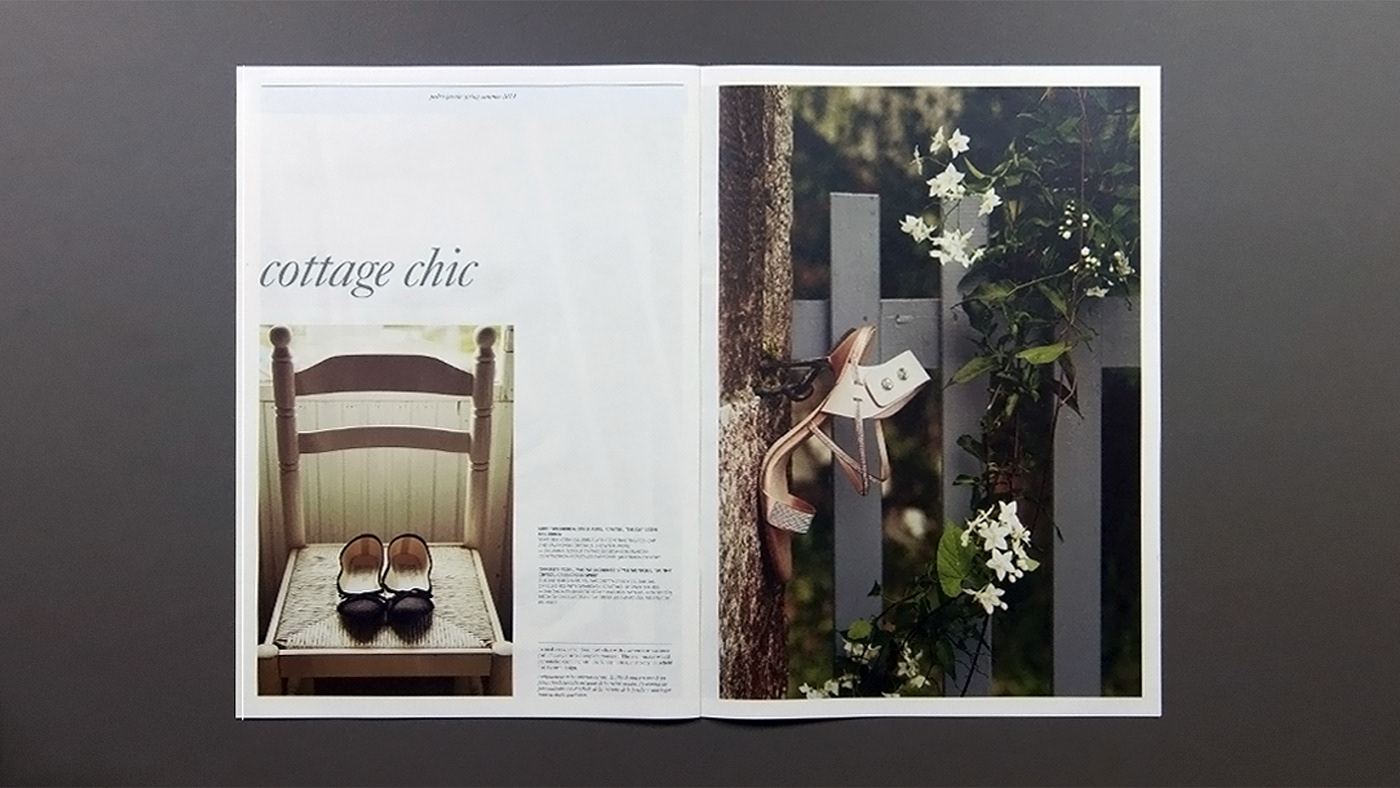
Cottage Chic
Below: Style Abril, ‘crystal cap-toe satin ballerina’ – Soft silk satin ballerina with contrasting toe-cap and Swarovski crystals. Shown in ivory.
Opposite page: Style Monique, ‘skinny crystal criss-cross spike’ – Silk satin and natural vacchetta spike heel sandal embellished with Swarovski crystals. Shown in nude.
In rural areas, a traditional chair with a seat woven from bulrushes was once part of every married couple’s trousseau. The chair-maker would personalize each one with the family monogram, and every household had its own design.
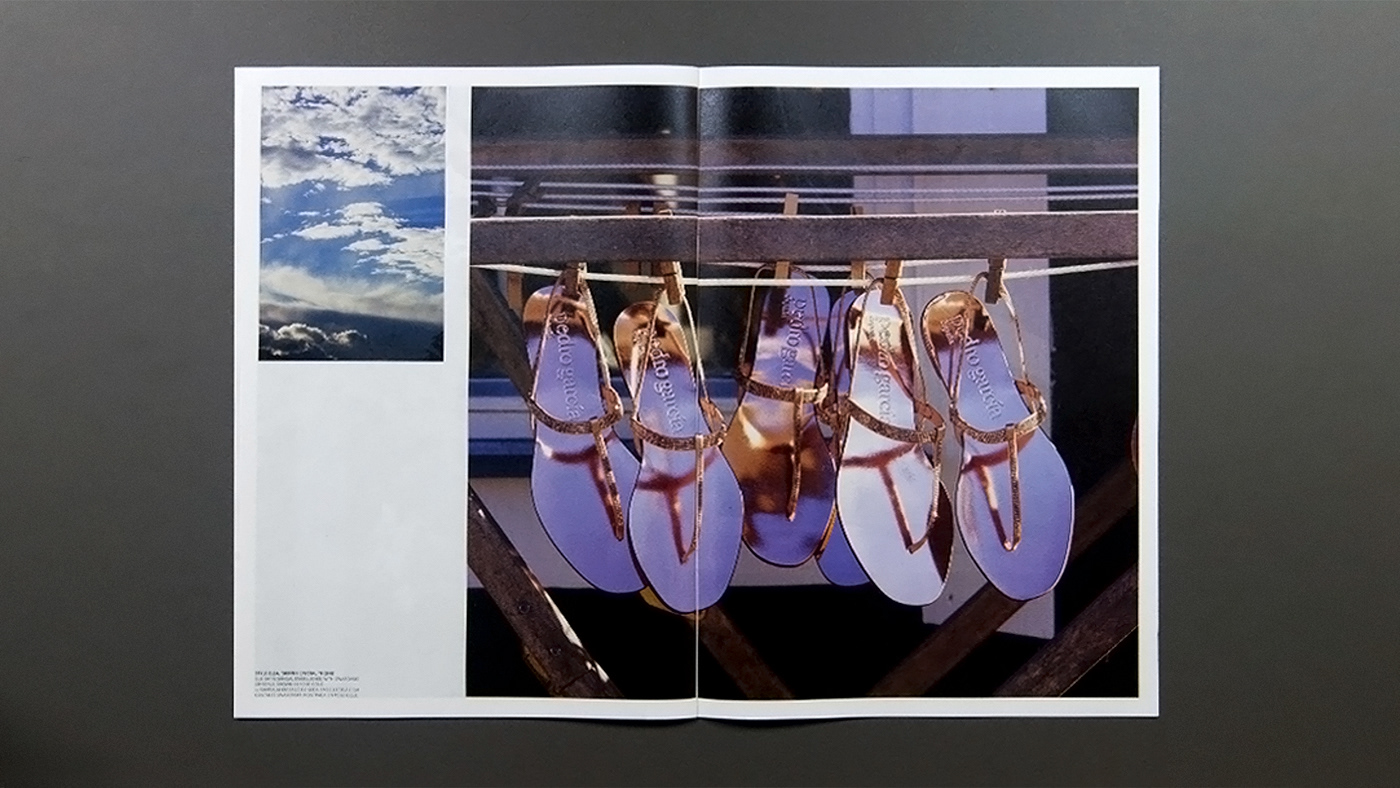
Style Ella, ‘skinny crystal thong’ – Silk satin sandal embellished with Swarovski crystals. Shown in rose gold.
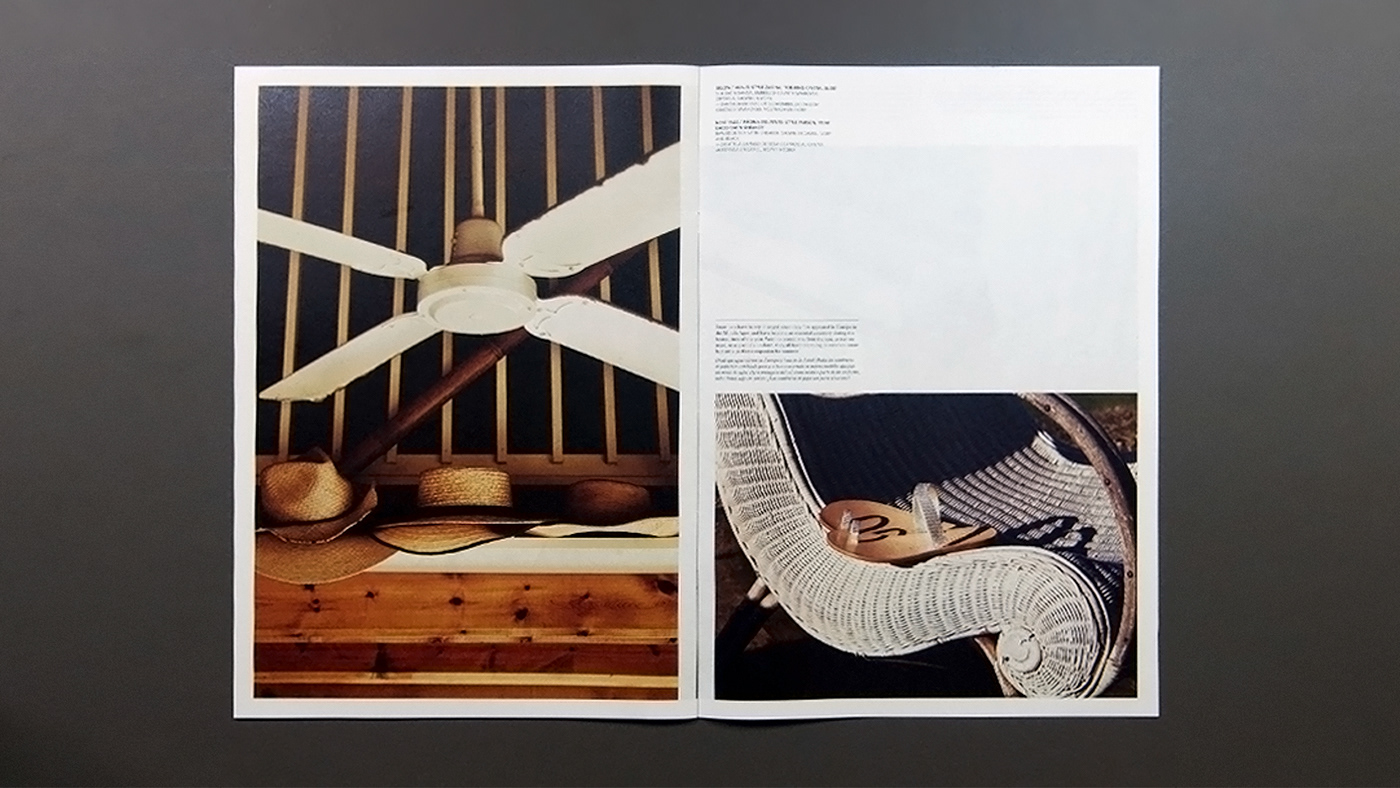
Below: Style Zarina, ‘toe-ring crystal slide’ –
Silk satin sandal embellished with Swarovski crystals.Shown in ivory.
Next page: Style Parson, ‘phat laced satin sneaker’ –
Next page: Style Parson, ‘phat laced satin sneaker’ –
Raw edge silk satin sneaker. Shown in camel, ivory and black.
Straw hats have barely changed since they first appeared in Europe in the Middle Ages, and have become an essential accessory during the hottest time of the year. Worn to protect you from the sun, to stay on trend, or as part of a uniform, they all have one thing in common: straw hats are a perfect companion for summer!

The more the merrier
The precursors of the sneaker, today’s ultimate comfort shoe, were simple rubber-soled plimsolls, with no marked left or right foot. It was the US Rubber Company that launched the first mass-produced canvas shoe with a rubber sole, and marketed it specifically for basketball. They came to be known as ‘sneakers’ because they made so much less noise than heavy-soled shoes – and is it was easy to sneak up on someone without being heard.

An apple a day...
Apples! Every imaginable variety, everywhere you look. Sweet as honey, bracingly bitter or deliciously sour. Round, plump, pudgy, dimpled, freckled and fragrant. When it comes to apples, Asturias is the land of plenty, and it has been since ancient times. The conservation of this rich genetic heritage is a task the region takes seriously. Thanks to “Nuevos Horizontes” – an interregional cooperation project in which two Asturian groups are participating – ten traditional varieties of apple have been saved from near-extinction. They’re apples that taste like apples. So every new harvest will produce better cider –sidra as it’s know here – the drink made from one of the healthiest fruits on the planet, the subject of intensive research. Salud!
Apples! Every imaginable variety, everywhere you look. Sweet as honey, bracingly bitter or deliciously sour. Round, plump, pudgy, dimpled, freckled and fragrant. When it comes to apples, Asturias is the land of plenty, and it has been since ancient times. The conservation of this rich genetic heritage is a task the region takes seriously. Thanks to “Nuevos Horizontes” – an interregional cooperation project in which two Asturian groups are participating – ten traditional varieties of apple have been saved from near-extinction. They’re apples that taste like apples. So every new harvest will produce better cider –sidra as it’s know here – the drink made from one of the healthiest fruits on the planet, the subject of intensive research. Salud!
The Guiding Light
Miles of exposed coastline, steep cliffs, rough seas and a climate prone to storms mean that lighthouses – the luminous towers that guide sailors safely back home – shine out along the length of the Asturian coast. The region has the highest concentration of lighthouses in Spain. But it’s not only at night that they have to be visible. They also play an important role as landmarks during the day. Some are painted with horizontal stripes, to make them stand out against a cloudy sky. Pictured above, the lighthouse at Cabo San Agustín, near Ortiguera.

Hang Ten
More than a sport, it’s an obsession. A never-ending quest for the perfect wave, nature’s ultimate gift. Surfers in Asturias, like surfers anywhere, live a freewheeling existence, pursuing happiness while respecting the environment and creating a lifestyle all their own. But who taught the Asturians, so far away from Hawaii or California, to ride the waves on a board? The vast, untamed beaches of north-eastern Spain, and those of Asturias in particular, were discovered by globetrotting Australian surfers in the seventies. They found their ideal home, or at least for a while. When their money ran out, they had to sell their boards to the locals to get by, ensuring that surf had come to stay. Although they had to go wherever the waves took them, surely the early Aussie surfers never forgot those endless waves, breaking on the rugged Asturian coast.
More than a sport, it’s an obsession. A never-ending quest for the perfect wave, nature’s ultimate gift. Surfers in Asturias, like surfers anywhere, live a freewheeling existence, pursuing happiness while respecting the environment and creating a lifestyle all their own. But who taught the Asturians, so far away from Hawaii or California, to ride the waves on a board? The vast, untamed beaches of north-eastern Spain, and those of Asturias in particular, were discovered by globetrotting Australian surfers in the seventies. They found their ideal home, or at least for a while. When their money ran out, they had to sell their boards to the locals to get by, ensuring that surf had come to stay. Although they had to go wherever the waves took them, surely the early Aussie surfers never forgot those endless waves, breaking on the rugged Asturian coast.
